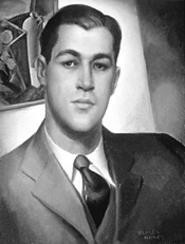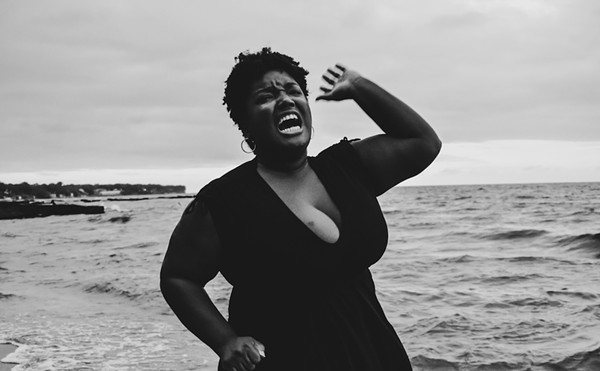And the viewer is compelled to comply. Even long-dead subjects seem alive here, crowding the Beck Center gallery with their presence. It's like a party where everyone's using telepathy instead of words.
The exhibition demonstrates the primary strength of portraiture: that it shows not only the subject, but also the artist's response to that subject.
The show's most unconventional piece -- Douglas Max Utter's 98-by-112-inch oil and mixed media on canvas, "Rain, Cleveland: I 90 and 116th St. (In Memory of Marjorie Fern Manifold Utter, November 1918-October 2000)" -- is not actually a portrait at all, but a landscape. Yet it takes the personal response of portrait artists to an extreme. Utter refuses to show his mother's corporeal existence, showing us instead how he feels about her death by excluding her from the painting.
It is that combination of psychological and physical realities that lends magic to the exhibition's 75 portraits by 50 artists.
Curator Marianne Berardi (this is her first show since becoming director of the foundation in September) wisely chose not to group the works chronologically, but to arrange them based on size, color, and treatment of subject. This method insists the viewer consider the portraits themselves, not the times in which they were painted, and contributes to the impression that the subjects are suspended in time.
Among the notables on display, there's Shaker Heights socialite Shirley Bryan Swetland. Artist Avis Andres depicts her as serenely smiling, a lovely woman with the wholesome blond looks popular in the 1970s. But there's a glint of mischief and fun in her face that belies the portrait's sedate pose and demure attitude. Somehow it's not too surprising to read that she later divorced her husband, moved to New York to pursue an acting career, and married an actor she fell for at the Cleveland Play House.
On a wall devoted to men in suits, there's the astonishing Alexander Warshawsky portrait of Dr. Paul Rea, the founding director of the Cleveland Museum of Natural History. This oil on canvas suggests the elongated creations of Modigliani, with Rea's pale face floating above the bold smudges of his dark suit. Standing stiffly, the thin man looks ready to stare down anyone who opposes his will, be it natives on a remote dig or museum staffers who have misplaced an artifact. (The painting apparently so disturbed present-day staff members that they asked that it be moved from the break area.)
Another suited man, in Eileen B. Ingalls's portrait of Joseph Newman --founder of Newman-Sterne Sporting Goods and author of humorous newspaper columns -- shows Newman, pencil in hand, looking as if he's just that moment noticed you and wonders what it is you need. (If for no other reason, see this picture to analyze his resemblance to his nephew, actor Paul.)
Elmer Novotny's 1929 "Portrait of John Cherry" shows a young man looking distinguished and handsome, on the brink of being old enough to have an interesting face; the light falls on him as if to promise a bright future (a bit of flattery from Novotny to a fellow student).
A few portraits are idealized. Sandor Vago's heavily brush-stroked oil on canvas, titled "Slovenian Girl," represents, perhaps, more the artist's nostalgia for his native Hungary than an actual woman. Her sweetly trusting face, her warm but wary look, the red flower she holds, the white blouse and shawl she wears, and the charming outdoor setting all make her seem the generic "peasant girl."
Some of the subjects are still very much alive, such as Kim Schoel, owner of the Dead Horse Gallery -- who uses bright, tropically colored oranges and greens for a disturbing yet appealing self-portrait that shows her as quite literally speechless, with no mouth. She's surrounded by enigmatic native symbols: Pointed wooden spikes radiate from the painting's frame, a dead bird rests in her hands, grass grows from her waist, and butterflies flit around her.
Another wonderfully rendered recent portrait, also imbued with symbols, is Ken Motz's oil "Portrait of Jim McCall." It shows British artist McCall wearing a T-shirt inscribed with a circular union jack, his head encircled by a Byzantine halo. He's looking down, holding a cane/shepherd's crook, and behind him rests a canvas of black sheep in a meadow (during this period, McCall painted only sheep). Since Jesus often compared men to sheep, with the injunction to his apostles to tend and feed them, the picture suggests that McCall, in his painterly way, is doing the same thing with black sheep.
For those of us trained by urban life to carefully avoid looking directly at people, lest it be rude or dangerous, it's a delight to relish these faces -- even if they do stare back with the cool implacability of those beyond caring what the viewer or anyone else thinks of them now.











